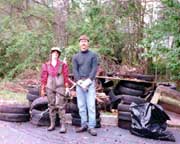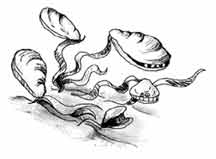 Out of Session: A Fairly Green Ending to General Assembly
Out of Session: A Fairly Green Ending to General Assembly
The General Assembly is packing up and clearing out of Annapolis, having committed to spend some $21.6 billion next year, while leaving a $780 million deficit for the next administration.
It's been for the lawmakers a pull-and-push kind of year, with the push a tight budget and the pull Gov. Parris Glendening's home-stretch run to secure his environmental legacy, and perhaps the new job he'll need to support a new family.
So how did our environment survive that push and pull?
The environmental achievements of the legislature of 2002 are, said Del. George Owings III, “never enough from some people and too much for others.” Still, the chairman of the House subcommittee in charge of environment and natural resources pronounced this “a very healthy session.”
Chesapeake Bay — and with it the Eastern Shore coastal bays of Worcester County — benefit from what legislators agree is the year’s big environmental achievement: broader Critical Areas protection.
“It’s our most important achievement,” said Del. Dick D’Amato.
On the ocean side, five back bays — Assawoman, Chincoteague, Isle of Wight, Newport and Sinepuxent — gain the protection of the 1,000-foot safe zone that has since 1987 buffered the
Chesapeake and its tributaries from development.
The action was needed, D’Amato explained, because “our coastal bays are a very fragile system. The pressure of development is too intense for them to survive without this kind of protection.”
What’s more, the buffer for both those bays and the Chesapeake was reinforced in this year’s General Assembly.
“We tightened up loopholes created in the Critical Areas law by our judiciary, which recently, disturbingly and surprisingly made unwise decisions on variances,” explained Del. Virginia Clagett, who as an Anne Arundel County councilwoman helped fashion the original law.
Under the new legislation, Senate President Mike Miller explained, “local jurisdictions must now consider the reasonable use of the entire parcel or lot for which a variance has been requested.”
On another environmental front, push hit pull. Smart Growth has been the bank in which Glendening has invested most of his environmental capital. With the one hand, Smart Growth works to focus growth in already developed communities, while with the other it works to preserve rural land from development.
In this assembly, each of Glendening’s three land preservation programs — GreenPrint, Rural Legacy and community parks and playgrounds — will do less next year than the governor hoped.
Still, that cloud had a silver lining.
“At one point, their fate was in jeopardy, but despite the poor economy, the governor and assembly were able to fund each of the three programs with general appropriation bonds,” said Mike Nelson of Department of Natural Resources. GreenPrint and Rural Legacy each will get about $15 million, while park and playgrounds gets $5.5 million.
On yet another environmental front, Program Open Space will lose about half its money next year. Program Open Space is funded with a one-half percent tax on all real estate transfers. For next year, that would have amounted to about $97 million — but the lawmakers transferred half that amount into their general fund.
“We had hoped the legislature would not take 50 percent; the governor had proposed a 25 percent reduction,” said Nelson. “But it was a tough year.”
Precedent worries Nelson even more than the one-year loss.
“In 1985,” he explains, “a similar cap was put on and it took 12 years to get it off. During that time, $470 million was diverted.”
Still, whether land preservation lost or gained in this year’s assembly depends on the angle from which you call it. Looking from a farm angle, Mike Miller called it a gain, noting that this year’s assembly “established a statewide 2022 goal to preserve triple the existing number of acres of productive agriculture land preserved by Maryland’s Agricultural Land preservation fund, GreenPrint, Rural legacy and local preservation programs.”
In addition to the big areas of increased Critical Areas protection and continued land preservation, legislation touched nearly a dozen environmental areas, from drinking water to underwater grasses.
Still, holding the line against disastrous funding losses seemed to rank near the top of everybody’s list of environmental achievements.
“We managed to close the gap on disproportionate proposals for environmental funding cuts,” said Therese Pierno, Chesapeake Bay Foundation Maryland executive director.
But Coastal Bays got the applause — in part because it was the last act of this year’s assembly. “It passed,” said Owings, “with only a minute or two in the session.”
— SOM
 GreenScape 2002: Come on Out and Bring Your Trowel
GreenScape 2002: Come on Out and Bring Your Trowel
Kicking off Annapolis’ spring 2002 GreenScaping, Mayor Ellen Moyer has been seen on West Street planting trees. It is not her first experience with a shovel on that boulevard. As First Lady Moyer, she planted saplings there 30 years ago. Reconstruction of West Street last year removed the trees. Now the mayor has replaced the trees with well-developed specimens, setting an example of the “high standards” she expects for the greening of her city.
Following the mayor’s lead, GreenScape 2002 officially blooms April 13 with the highest commitment yet of community time and services. Beginning at 8:30am, says chairwoman Sandi Patty, volunteer planters will be decked out with gloves, hats and water bottles, donated this year by Baltimore Gas and Electric, PEPCO Energy Services and Environmental Resources Management Inc.
Bring a trowel and wear your blue jeans. On this 11th anniversary of GreenScape, 2,650 plants and 94 trees will start 68 new gardens. There are still plenty of ways to get involved.
At Chesapeake Children’s Museum on Spa Creek, join some 250 Junior Girl Scouts planting flowers, berry bushes and native grasses in the Spa Creek Conservancy, controlling erosion, providing habitats and beautifying the landscape.
At the Arc of Anne Arundel County, coordinator Mel Wilkins says there’s plenty of opportunity to “weed, weed, weed, plant and mulch.” About 150 new plantings will supplement the unique Sensory Gardens, designed to activate brain cells with masses of color and contrasting textures, and with plantings to attract butterflies and hummingbirds. The gardens at Arc are also Marylandscapes, grown with Bay-friendly plants native to Maryland. The Arc and TKF Foundation follow planting with a picnic for all volunteers.
Three hundred and some native geraniums, as well as perennials, grasses and shrubs provided by GreenScape and Chesapeake Bay Trust will brighten the largest gardening endeavor yet at Maryland Hall. The Founder’s Green landscaping project, which includes a labyrinth with painter’s circle, will be planted by 20 midshipmen from the Naval Academy Women’s Soccer Team and other community volunteers. Volunteer coordinator Louise White needs people willing to give a few hours every month to help maintain the plantings, which are largely native.
GreenScape 2002 flourishes on native species that adapt well to local conditions. These plants stay healthy with minimal watering, a big bonus in our drought conditions, and without the use of chemical pesticides or fertilizers, a big bonus for the Bay anytime. Native plantings also attract and shelter songbirds and butterflies.
 |
photo courtesy of GreenScape
Students, teachers and other volunteers will join Annapolis Recreation and Parks crews beginning April 13 in a city-wide effort to spruce up the greater community, gathering trash and planting flowers, trees and shrubs. |
Interested in helping out? People will be planting in all but one of the city’s eight wards. A garden in memory of teacher and social studies department chair Frank Draper is going in at Annapolis High School. St. Mary’s Athletic Association is planting on the Weems/Whalen ball fields. Germantown-Homewood Association will be busy on the Poplar Trail, where BGE is trimming trees and working in cooperation with homeowner associations. New trees and shrubs are going in on the median of Aris T. Allen Boulevard. Come on out, rain or shine.
GreenScape is sponsored by the Annapolis Recreation and Parks Advisory Board. Find your place with a call to Annapolis Parks and Recreation: 410/263-7958 • ARC: 410/268-8085 • Chesapeake Children’s Museum 410/990-1993 • Maryland Hall, Louise White: 410/263-5544.
—Martha Blume
 Oyster Gardener’s Journal: Life Is Irrepressible
Oyster Gardener’s Journal: Life Is Irrepressible
Spring has sprung. Cherry trees, forsythia and the pear trees’ snowball blossoms are giving way to bursts of green leaves. What will the change of seasons mean for my oyster garden?
On a crisp, breezy afternoon, I haul up four cages containing the several hundred baby oysters, or spat, I have been cultivating since autumn. It’s a shocking sight: My once-pristine oyster cages are covered with a fuzz of tiny barnacles and an overlay of silky-fine algae. Good grief, I think, can it be this long since I last checked them? I thought nothing grew in the winter. I fear for my charges inside.
It’s been a dismal year for oysters overall. The commercial oystering season has just ended, and although the numbers aren’t official yet, the estimates are grim: Maryland’s watermen hauled in a mere 122,000 bushels of oysters this year, the second-worst season in 131 years of state record-keeping. It’s barely a third of last year’s count. And it pales beside the millions of bushels once harvested from this Great Shellfish Bay. What on earth has happened?
Actually, the answer to this year’s dearth of oysters lies in what didn’t happen – namely, rain – according to John Surrick of the Maryland Department of Natural Resources. “It’s the drought we’ve been having,” he explained. With low rainfall, salinity increased in the Bay and its tributaries. Oysters like salty water, but so do the two diseases, Dermo and MSX, that have ravaged the Bay’s native oysters. With the higher salinity, MSX has crept northward through the Bay, and Dermo has also increased its presence.
Knowing all this, I feel apprehensive as I unclip the cages’ fasteners, toss two trapped fish back into the river and inspect my charges. Sea squirts cling to some of the shells; others bear a fine layer of silt and oyster feces. I poke and prod, searching for signs of life. The first spat shells gape rigidly open like hungry mouths searching vainly for sustenance from the sea. It’s a bad sign: spat with open shells are dead. Bay-wide oyster mortality rates neared 40 percent this year. What will be the survival rate in my small cages?
Yet as I continue rummaging through the cages, I find spat with closed shells, and big ones, at that. Last fall, these baby oysters were as small as my fingernail. Now, my heart thrills to discover they have grown to nearly the size of my thumb. I am not making any scientific survey at this point (although I’ll collect oyster data later this month). But my sampling is enough to awe me: Nature has worked her miracles once again. During the long winter months when the oysters lay largely dormant, when I did little to tend to them except protect them from freezing air, my young charges continued to thrive and grow — sea squirts, barnacles, algae and all.
Looking at my messy oyster cages, I realize I’ve been lulled by this year’s mild-mannered non-winter: I’d barely noticed time’s passage or the change of seasons until spring snuck up on me, full-blown and undeniable. My flower beds lie unmulched. My oyster cages bear a crust of barnacles and algae.
But all this unruly new growth brings a surge of joy: Even dandelions herald renewal and new life. My budding oysters look like fine, proud shellfish to me, worthy of any waterman’s prize. An inch-long spat here, a thumb-sized one there. I find comfort in the shells lying safely closed, snug and firm. In the face of Bay-wide attrition, some oysters still thrive.
I let the cages dry on the dock for a few hours to kill the algae and to loosen the barnacles. As I lower my oysters into the river, a breeze scuds over the water. My spirit soars.
No doubt about it: It’s spring.
—April Falcon Doss
 Way Downstream …
Way Downstream …
In Virginia, the Ghost Fleet of the James River — actually the 97-ship James River Reserve Fleet — is posing serious water pollution threats, the Virginian-Pilot reports in an engrossing new series. Read about it at www.pilotonline.com/special/ghostfleet/…
In Miami, the hurricane forecast suggests that you’d better get some strong dock lines for the coming season. Predictors say we’re likely to get seven hurricanes and five other tropical storms in the June 1 to November 30 season, including a 75 percent chance of one really major storm with sustained winds of at least 111 mph …
In Canada, they’re paying cash prizes for top gunners in the 2002 Ken Turcott Memorial Gopher Derby — a contest named after a renowned gopher hater to rid the province of Saskachewan of the crop-eating rodents. Animal rights advocates call it the Gopher Killing Derby and want a more humane method of extermination ...
In Nepal, teams have climbed Mount Everest before to rid the world’s highest peak of garbage. But on April 12, a four-nation team planned another trek to bring down bodies that have perished there over the years. At least 167 people have died on the 29,035-foot mountain, and some remain there frozen because harsh weather has prevented removal …
Our Creature Feature comes from Scotland, where the escape of 10,000 salmon from a fish farm this month threatens dwindling salmon stocks in the North Atlantic. The farmed fish compete with the wild salmon for food, dilute the genes with mating and might even spread diseases, researchers said.
Environmental advocates say the incident is another reason why the U.S. and other governments should put a stop to efforts to create genetically engineered salmon, which grow faster but could devastate the natural species if the altered fish escape captivity.